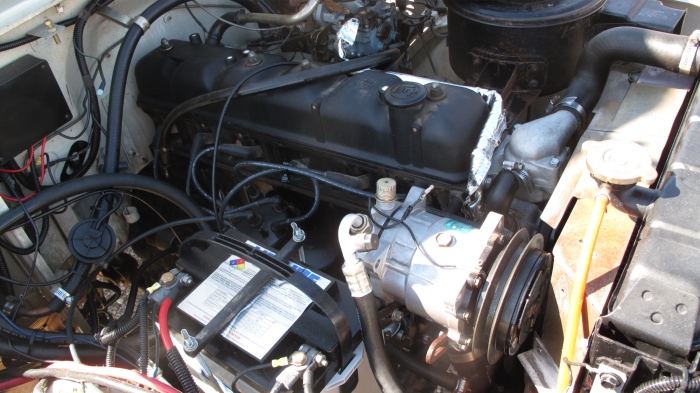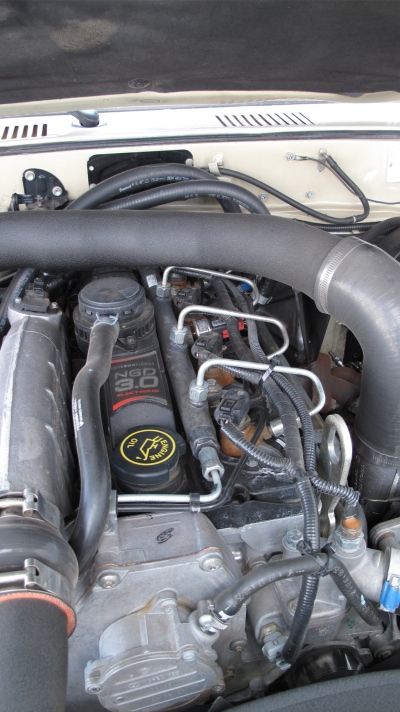
Overland Tech and Travel
Advice from the world's
most experienced overlanders
tests, reviews, opinion, and more
The Myth of Compression Braking
 Recently a remark by an acquaintance triggered me to dredge up a bit of knowledge I came by ages ago, during a short stint driving a diesel tractor/trailer rig for J.C. Penney between Phoenix and Tucson. The fellow, a UK resident, had recently sold his mid-90s Land Rover Discovery V8 with a five-speed manual transmission, and purchased a similar Discovery equipped with a 200 Tdi turbodiesel engine, also with a five-speed. Besides instantly doubling his fuel economy and then some, he’d noticed something else and mentioned it in an email. “I might be daft,” he wrote, “but I swear the petrol engine had better compression braking. But I know that’s impossible. It only had 9:1 compression, and the Tdi is 19:1. Something else must be at work.”
Recently a remark by an acquaintance triggered me to dredge up a bit of knowledge I came by ages ago, during a short stint driving a diesel tractor/trailer rig for J.C. Penney between Phoenix and Tucson. The fellow, a UK resident, had recently sold his mid-90s Land Rover Discovery V8 with a five-speed manual transmission, and purchased a similar Discovery equipped with a 200 Tdi turbodiesel engine, also with a five-speed. Besides instantly doubling his fuel economy and then some, he’d noticed something else and mentioned it in an email. “I might be daft,” he wrote, “but I swear the petrol engine had better compression braking. But I know that’s impossible. It only had 9:1 compression, and the Tdi is 19:1. Something else must be at work.”
I wrote him back a short reply: “That’s because diesel engines have no compression braking.” Which caused him to respond, “Now I think you’re daft.”
 Recently a remark by an acquaintance triggered me to dredge up a bit of knowledge I came by ages ago, during a short stint driving a diesel tractor/trailer rig for J.C. Penney between Phoenix and Tucson. The fellow, a UK resident, had recently sold his mid-90s Land Rover Discovery V8 with a five-speed manual transmission, and purchased a similar Discovery equipped with a 200 Tdi turbodiesel engine, also with a five-speed. Besides instantly doubling his fuel economy and then some, he’d noticed something else and mentioned it in an email. “I might be daft,” he wrote, “but I swear the petrol engine had better compression braking. But I know that’s impossible. It only had 9:1 compression, and the Tdi is 19:1. Something else must be at work.”
Recently a remark by an acquaintance triggered me to dredge up a bit of knowledge I came by ages ago, during a short stint driving a diesel tractor/trailer rig for J.C. Penney between Phoenix and Tucson. The fellow, a UK resident, had recently sold his mid-90s Land Rover Discovery V8 with a five-speed manual transmission, and purchased a similar Discovery equipped with a 200 Tdi turbodiesel engine, also with a five-speed. Besides instantly doubling his fuel economy and then some, he’d noticed something else and mentioned it in an email. “I might be daft,” he wrote, “but I swear the petrol engine had better compression braking. But I know that’s impossible. It only had 9:1 compression, and the Tdi is 19:1. Something else must be at work.”
I wrote him back a short reply: “That’s because diesel engines have no compression braking.” Which caused him to respond, “Now I think you’re daft.”
My next email was much longer, and read something like this:
First, the term “compression” braking is a misnomer. While there are several forces at work (including simple internal friction) when a driver lifts off the throttle in a vehicle and the engine slows it, the force often referred to as compression braking is more accurately called vacuum braking. It occurs in a gasoline engine because the throttle, i.e. the gas pedal, works by regulating the amount of air entering the engine—the fuel-to-air ratio is kept relatively constant. The air flow is controlled by a rotating plate or series of plates in the fuel injection’s intake system (or, in older vehicles, in the carburetor). When you lift off the gas pedal, that plate closes off the intake nearly completely. The engine, which is still turning at speed via its connection to the turning wheels, then has to suck air past the closed plate, and that retards the engine, and that is what allows our manual-transmission, gasoline-engined vehicles to creep down quite steep inclines in first gear low range, without the need for brakes.
A diesel engine is different. In a diesel, the throttle controls the amount of fuel being injected into the engine, rather than the air flow. The air intake system in a diesel is always fully open. Thus, when you lift off the pedal in a diesel-engined vehicle, the fuel supply is reduced, but there is no vacuum effect to slow the engine. Thus, no “compression” braking.
You might ask, but what about the air still being compressed in each cylinder as the piston rises on that 19:1 compression stroke? Doesn’t that retard the engine? The answer is, yes, it does; however, once the piston passes top dead center, that compressed air is still pushing against the piston, only now it’s trying to speed up the engine, even without enough fuel injected to produce real power via combustion. So the two forces essentially cancel each other (the same effect applies to gasoline engines).
 Opening photo: A 3.8-liter gasoline engine. This photo: A 3.0-liter Turbodiesel. Which one has more engine braking?
Opening photo: A 3.8-liter gasoline engine. This photo: A 3.0-liter Turbodiesel. Which one has more engine braking?
This lack of what we really should just refer to as engine braking is why many big diesel trucks, such as that J.C. Penney tractor/trailer rig, employ what is known generically as a Jake brake, after Jacobs, the company that originally manufactured the device. A Jake brake opens the exhaust valve on each cylinder at the top of the compression stroke, so the compressed air is released out the exhaust (with a machine-gun-like hammering that prompts communities to post those signs prohibiting their use within urban areas). That leaves just the compression stroke working to retard the engine—so a diesel truck with a Jake brake really does have compression braking.
The exhaust brake is another, quieter (although generally less effective) method of engine braking on a diesel truck. This device partially closes off the exhaust, so the air pushed out through the exhaust valve on the exhaust stroke is restricted, slowing the engine and the vehicle. Some trucks now employ both Jake and exhaust brakes to maximize efficiency while reducing noise.
So that’s why an engine with more compression can have less “compression” braking.
I checked: Unfortunately, Jacobs doesn’t make a model for the 200 Tdi . . .
Hint: When using “Search,” if nothing comes up, reload the page, this usually works. Also, our “Comment” button is on strike thanks to Squarespace, which is proving to be difficult to use! Please email me with comments!
Overland Tech & Travel brings you in-depth overland equipment tests, reviews, news, travel tips, & stories from the best overlanding experts on the planet. Follow or subscribe (below) to keep up to date.
Have a question for Jonathan? Send him an email [click here].
SUBSCRIBE
CLICK HERE to subscribe to Jonathan’s email list; we send once or twice a month, usually Sunday morning for your weekend reading pleasure.
Overland Tech and Travel is curated by Jonathan Hanson, co-founder and former co-owner of the Overland Expo. Jonathan segued from a misspent youth almost directly into a misspent adulthood, cleverly sidestepping any chance of a normal career track or a secure retirement by becoming a freelance writer, working for Outside, National Geographic Adventure, and nearly two dozen other publications. He co-founded Overland Journal in 2007 and was its executive editor until 2011, when he left and sold his shares in the company. His travels encompass explorations on land and sea on six continents, by foot, bicycle, sea kayak, motorcycle, and four-wheel-drive vehicle. He has published a dozen books, several with his wife, Roseann Hanson, gaining several obscure non-cash awards along the way, and is the co-author of the fourth edition of Tom Sheppard's overlanding bible, the Vehicle-dependent Expedition Guide.



